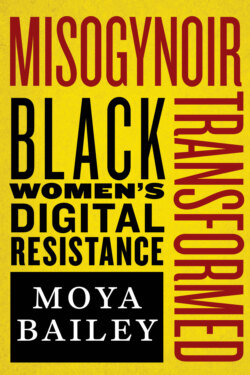Читать книгу Misogynoir Transformed - Moya Bailey - Страница 11
Misogynoir in Policy
ОглавлениеDuring the 1940s, Black women who were in the hospital for any reason could be given hysterectomies without their consent or knowledge. This practice was so widespread in Mississippi it was dubbed a “Mississippi appendectomy.”24 Famed civil rights activist Fannie Lou Hamer was one of the women subjected to this practice, and the experience was a major impetus for her activism.25 Sterilization abuse as a tool of white supremacy exceeded the Jim Crow era and continued well into the 1970s with victims like the young Relf sisters in Alabama, sterilized without their knowledge or consent as teenagers.26 These practices were supported by media representations like Warner Brothers’ Coal Black and de Sebben Dwarfs, which portrayed Black women as sexually irresponsible and in need of outside intervention.27
During the late 1970s and early 1980s, media outlets and political officials constructed the image of the “welfare queen” to justify federal policy decisions that cut social services for millions of US Americans.28 Using the case of Linda Taylor, who in 1974 defrauded the welfare system of $8,000 among other much more serious crimes, President Reagan and his administration painted a picture of Black women willfully taking advantage of governmental aid.29 Despite the fact that the very rare occasion of welfare fraud was generally committed by men (as former NFL player Brett Favre’s 2020 payments of over one million dollars in restitution to the Mississippi Temporary Assistance for Needy Families attests), the representation of Black women as the culpable parties remains to this day.30 The welfare queen was depicted as an irresponsible Black woman who was having kids and getting rich from government checks. She got a “handout” for having lots of children and being unmarried. In a 1999 Harvard study on the impact of “welfare queen” imagery on participants’ ideas about welfare reform, “the most gender liberal white participants appear to be most likely to implicitly blame African-Americans for the plight of their racial peers, and there is early evidence to suggest that this tendency is most pronounced among women.”31 Language and images about the “welfare queen” were used to stoke misogynoiristic sentiment that was leveraged into actual legislation. The Personal Responsibility and Work Opportunity Act of 1996 was the culmination of years of Republican efforts to reduce the number of people using government assistance; it overhauled the welfare system by creating time limits for the use of assistance as well as work and marriage requirements, which were all designed to re-engineer Black women’s perceived dependence on the welfare state. The circulation of the myth of the welfare queen negatively impacted Black women by limiting federal resources that provided beneficiaries access to food, money, and healthcare.32 Black women’s access to the very means of life were curtailed for themselves and others because of the misogynoiristic image of the “welfare queen.” Even though most welfare recipients were at that time and still are white, one Black woman’s abuse of the system and the Moynihan Report were used by politicians to portray the Black family, particularly Black women, as pathological.
Daniel Patrick Moynihan, assistant secretary of labor in the Lyndon B. Johnson presidential administration, took it upon himself to investigate poverty in Black families. In his 1965 report, “The Negro Family: The Case for National Action,” he noted that the major threat to racial equity was the deviant nature of the Black family, in which Black women often took on the role of head of household and primary breadwinner. Rather than address the structural impediments that made it difficult for Black men to find work, Moynihan pathologized the Black family, painting Black women’s marginal success in finding work outside the home as a form of emasculation that further inhibited Black men’s industry by making them depressed.33 Rather than address the undergirding white supremacist, capitalistic, and heteronormative imperative implicit in the idealization of the nuclear family and man as the rightful money maker of the home, Moynihan demonized Black women. This Sapphiric representation of Black women as emasculating Black men and the welfare queen’s continued circulation are examples of misogynoir’s ability to create material consequences that harm Black women’s health because these ideas informed and shaped public policy.
By the 1990s, anxieties around Black motherhood were further energized in the context of the burgeoning crack epidemic. An organization called CRACK (Children Requiring a Caring Kommunity) responded to the crisis by offering $200 to women of color using crack cocaine if they agreed to long-term or permanent birth control.34 Instead of offering resources or assistance to help the women overcome their addictions, CRACK promoted sterilization through this small monetary incentive. Comparatively, the 2010s opioid crisis, which has disproportionately affected white communities, has not seen similar tactics designed to sterilize white women drug users. White users are not criminalized, and the crisis has been treated as a public health problem. In the 1990s, news media described the children of users as “crack babies,” while media headlines in the 2010s discussed the plight of “opioid dependent newborns.”35 Black mothers are not afforded the same types of help or public compassion that white mothers are. As in the case of the “father of gynecology” or the 1940s sterilization abuses in North Carolina and Mississippi among other places, the supposed good intentions of these efforts are overshadowed by the misogynoirist foundations on which these projects were built.
